Plant Information-Herbaceous (alphabetical)
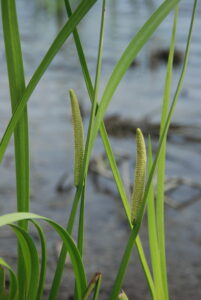
Acorus americanus (sweet flag)
Herbaceous, perennial clump grass with leaves similar to an iris. Tolerated dry periods and acidic conditions. Inconspicuous green spathes form in late spring.
- Wetland Indicator Status: OBL (Obligate Wetland)
- Height Range: 2 – 3 ft.
- Water Tolerance: Near MHW or regular inundation (0 – 6 in.)
- Light: Full sun to partial sun/shade
- Rate of Spread: Medium
- Bloom color: Green
- Drought tolerance: Medium
- Bloom period: April through May
- Wildlife Value: Provides food and shelter to many organisms
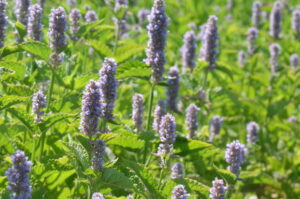
Agastache foeniculum (anise hyssop)
Herbaceous, perennial with blue/purple spike flowers blooming in late summer. Foliage is licorice scented. Broad cordate leaves are found along the stem.
- Wetland Indicator Status: NI (No Indicator)
- Height Range: 2 – 3 ft.
- Water Tolerance: Irregular inundation and upland
- Light: Full sun to partial sun/shade
- Rate of Spread: Medium
- Bloom color: Blue/purple
- Drought tolerance: High
- Bloom period: June through September
- Wildlife Value: Attracts pollinators
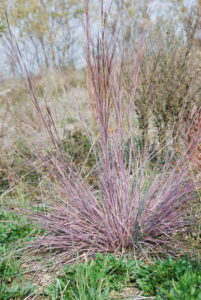
Andropogon virginicus (broomsedge)
Herbaceous, perennial clump grass. Provides excellent ground cover as well as seed for upland game and songbirds. Persistent in winter.
- Wetland Indicator Status: FAC (Facultative)
- Height Range: 1 – 3 ft.
- Water Tolerance: Irregular inundation and upland
- Light: Full sun
- Rate of Spread: Slow
- Bloom color: Beige
- Drought tolerance: High
- Bloom period: September through November
- Wildlife Value: Provides seed for upland game and songbird
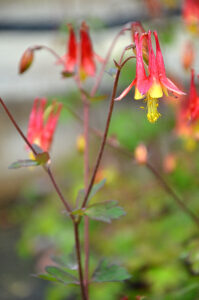
Aquilegia canadensis (red columbine)
Herbaceous, perennial with delicate, drooping red flowers. Attracts hummingbirds.
- Wetland Indicator Status: FACU (Facultative Upland)
- Height Range: 1 – 3 ft.
- Water Tolerance: Irregular inundation and upland
- Light: Full sun to partial sun/shade
- Rate of Spread: Medium
- Bloom color: Red
- Drought tolerance: High
- Bloom period: April through July
- Wildlife Value: Attracts hummingbirds and pollinators
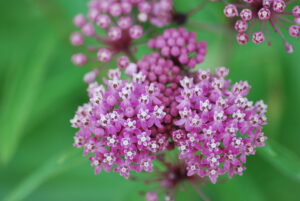
Asclepias incarnata (swamp milkweed)
Herbaceous, perennial with pale pink flowers blooming in the summer. Nectar is a great source of food for Monarchs and other pollinators.
- Wetland Indicator Status: OBL (Obligate Wetland)
- Height Range: 4 – 6 ft.
- Water Tolerance: Seasonal inundation
- Light: Full sun to partial sun/shade
- Rate of Spread: Slow
- Bloom color: Pale pink
- Drought tolerance: Low
- Bloom period: June through August
- Wildlife Value: Source of food for Monarchs and pollinators
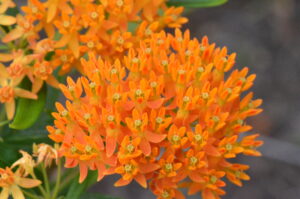
Asclepias tuberosa (butterfly milkweed)
Herbaceous, perennial prized for its vivid orange blooms. The dark green 2-3 in. long, lance shaped leaves add to the striking look of this monarch host plant.
- Wetland Indicator Status: NI (No Indicator)
- Height Range: 1 – 3 ft.
- Water Tolerance: Irregular inundation and upland
- Light: Full sun to partial sun/shade
- Rate of Spread: Slow
- Bloom color: Orange
- Drought tolerance: High
- Bloom period: May through July
- Wildlife Value: Monarch butterfly host plant; attracts butterflies and other pollinators
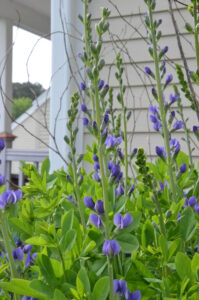
Baptisia australis (blue false indigo)
Herbaceous, perennial with blue-violet flowers. Has a shrub like form and fixes nitrogen. Can tolerate poor soils and attract pollinators.
- Wetland Indicator Status: FACU Facultative Upland)
- Height Range: 3 – 4 ft.
- Water Tolerance: Irregular inundation and upland
- Light: Full sun
- Rate of Spread: Medium
- Bloom color: Blue/violet
- Drought tolerance: Low
- Bloom period: April through July
- Wildlife Value: Source of food for pollinators
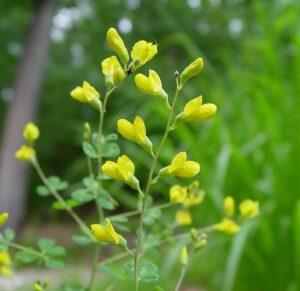
Baptisia tinctoria (yellow wild indigo)
Herbaceous, perennial with yellow flowers. Fixes nitrogen. Can tolerate poor soils and attract pollinators.
- Wetland Indicator Status: NI (No Indicator)
- Height Range: 1 – 3 ft.
- Water Tolerance: Irregular inundation and upland
- Light: Full sun to partial shade/sun
- Rate of Spread: Slow
- Bloom color: Yellow
- Drought tolerance: High
- Bloom period: May through September
- Wildlife Value: Source of food for pollinators
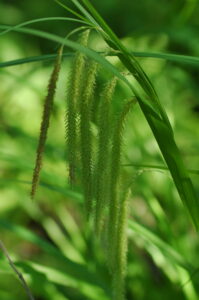
Carex crinita (fringed sedge)
Herbaceous, perennial grass-like sedge with densely tufted culms. Native emergent with drooping seed heads.
- Wetland Indicator Status: FACW (Facultative Wetland)
- Height Range: 1 – 3 ft.
- Water Tolerance: Irregular inundation
- Light: Full sun to partial shade/sun
- Rate of Spread: Medium
- Bloom color: Green/brown
- Drought tolerance: Low
- Bloom period: May through June
- Wildlife Value: Habitat for wetland creatures
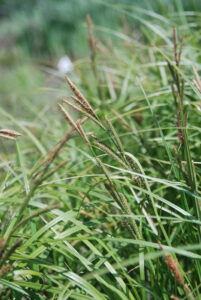
Carex stricta (tussock sedge)
Herbaceous, perennial sedge that has very high value as a food source for wildlife.
- Wetland Indicator Status: OBL (Obligate Wetland)
- Height Range: 2 – 4 ft.
- Water Tolerance: Regular inundation (0 – 6 in.)
- Light: Full sun
- Rate of Spread: Medium
- Bloom color: Green/brown
- Drought tolerance: Low
- Bloom period: May through June
- Wildlife Value: Food source
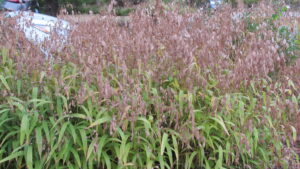
Chasmanthium latifolium (northern sea oats)
Herbaceous, perennial that provides good texture and erosion control for plantings. Attractive seed heads eaten by birds and small mammals. Butterfly host plant. Can grow in soils with a pH of 5.0 – 7.0.
- Wetland Indicator Status: FAC (Facultative)
- Height Range: 1.5 – 5 ft.
- Water Tolerance: Seasonal inundation and upland
- Light: Full sun to partial sun/shade
- Rate of Spread: Medium
- Bloom color: Green/brown
- Drought tolerance: High
- Bloom period: August through September
- Wildlife Value: Food source and butterfly host plant
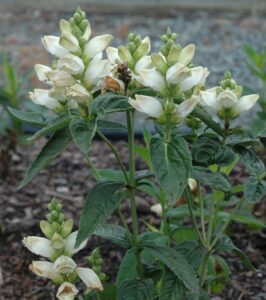
Chelone glabra (white turtlehead)
Herbaceous, perennial with white flowers tinged with pink. Host plant for butterflies and enjoyed by hummingbirds. Flowers resemble turtles.
- Wetland Indicator Status: OBL (Obligate Wetland)
- Height Range: 1.5 – 4 ft.
- Water Tolerance: Irregular to permanent inundation
- Light: Full sun to partial sun/shade
- Rate of Spread: Medium
- Bloom color: White
- Drought tolerance: Low
- Bloom period: August through October
- Wildlife Value: Butterfly host plant and hummingbird attractor
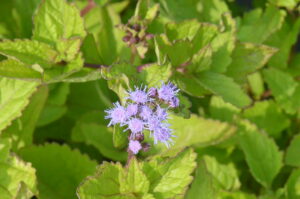
Conoclinium coelestinum (purple mistflower)
Herbaceous, perennial with blue/purple fine-textured blooms in late summer/early fall. Can form dense strands. Enjoyed by beneficial insects. Grows in soils with a pH of 5.5 – 7.5.
- Wetland Indicator Status: FAC (Facultative)
- Height Range: 1 – 3 ft.
- Water Tolerance: Seasonal inundation and upland
- Light: Partial sun/shade to full shade
- Rate of Spread: Medium
- Bloom color: Blue/purple
- Drought tolerance: High
- Bloom period: July through October
- Wildlife Value: Attracts beneficial insects
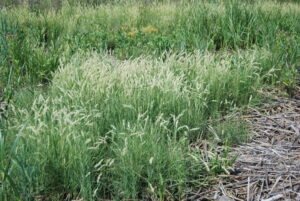
Distichlis spicata (spike grass)
Herbaceous, perennial grass found in high salinity depressions. Often intermixed with Spartina patens.
- Wetland Indicator Status: OBL (Obligate wetland)
- Height Range: 8 – 16 in.
- Water Tolerance: Above MHW (Mean High Water)
- Light: Full sun
- Rate of Spread: Rapid
- Bloom color: Yellow/brown
- Drought tolerance: High
- Bloom period: August through October
- Wildlife Value: Source of habitat and/or food
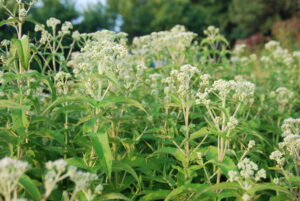
Eupatorium perfoliatum (boneset)
Herbaceous, perennial with small white flowers that bloom in the summer/fall. Attracts a variety of pollinators.
- Wetland Indicator Status: FAC (Facultative)
- Height Range: 2 – 5 ft.
- Water Tolerance: Irregular inundation and upland
- Light: Full sun to partial sun/shade to full shade
- Rate of Spread: Slow
- Bloom color: White
- Drought tolerance: High
- Bloom period: July through October
- Wildlife Value: Attracts pollinators
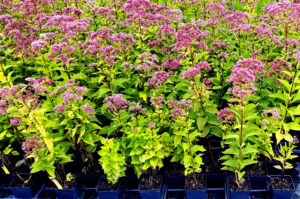
Eutrochium dubium (joe-pye weed)
Herbaceous, perennial with small purple flowers arranged in clusters. Nectar source for butterflies and beneficial insects.
- Wetland Indicator Status: FACW (Facultative wetland)
- Height Range: 2 – 5 ft.
- Water Tolerance: Seasonal inundation and upland
- Light: Full sun to partial sun/shade
- Rate of Spread: Slow
- Bloom color: Purple
- Drought tolerance: High
- Bloom period: July through September
- Wildlife Value: Attracts beneficial insects
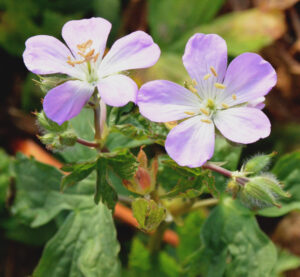
Geranium maculatum (wild geranium)
Herbaceous, perennial with pink/lavender flowers, blooms April-July; attracts bees and other beneficial insects; may become dormant in hot weather.
- Wetland Indicator Status: FACU (Facultative upland)
- Height Range: 1.5 – 2 ft.
- Water Tolerance: Upland
- Light: Full sun to partial sun/shade
- Rate of Spread: Slow
- Bloom color: Pink/Purple
- Drought tolerance: Low
- Bloom period: April-July
- Wildlife Value: Attracts bees and other beneficial insects
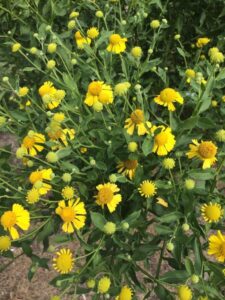
Helenium autumnale (yellow sneezeweed)
Herbaceous, perennial with vibrant yellow blooms from summer to fall. Attracts butterflies. Grows best in moist to wet soils.
- Wetland Indicator Status: FACW (Facultative Wetland)
- Height Range: 1.5 – 6 ft.
- Water Tolerance: Irregular to permanent inundation
- Light: Full sun to partial sun/shade to full shade
- Rate of Spread: Medium
- Bloom color: Yellow
- Drought tolerance: High
- Bloom period: July through November
- Wildlife Value: Attracts butterflies
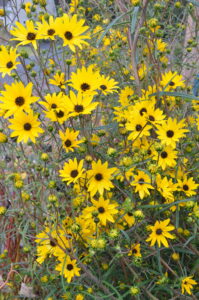
Helianthus angustifolius (swamp sunflower)
Herbaceous, perennial with bright yellow blooms from late summer to fall. Butterflies and songbirds are attracted to the nectar. Grows In soil with a pH of 4.0 – 7.0.
- Wetland Indicator Status: FACW (Facultative Wetland)
- Height Range: 1.5 – 5.5 ft.
- Water Tolerance: Irregular to permanent inundation
- Light: Full sun
- Rate of Spread: Medium
- Bloom color: Yellow
- Drought tolerance: High
- Bloom period: August through October
- Wildlife Value: Attracts butterflies and songbirds
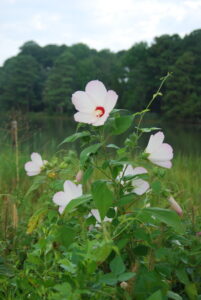
Hibiscus moscheutos (marsh hibiscus)
Herbaceous, perennial with large white, pink, or red flowers booming in the late summer. Seed capsules persist through winter. Can tolerate dry periods. Nectar is a food source for ruby-throated hummingbirds.
- Wetland Indicator Status: OBL (Obligate Wetland)
- Height Range: 4 – 7 ft.
- Water Tolerance: Near MHW or regular inundation (0 – 3 in.)
- Light: Full sun or partial sun/shade
- Rate of Spread: Slow
- Bloom color: White/Pink/Red
- Drought tolerance: High
- Bloom period: July through September
- Wildlife Value: Attracts hummingbirds
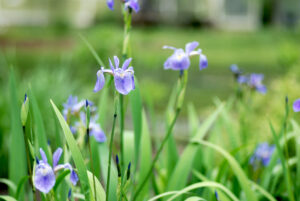
Iris versicolor (blue flag iris)
Herbaceous, perennial with blue/purple showy flowers in the late spring. Grows in clumps. Limited wildlife value. Requires full sun for flowering.
- Wetland Indicator Status: OBL (Obligate Wetland)
- Height Range: 1 – 3 ft.
- Water Tolerance: Regular inundation (0 – 6 in.)
- Light: Full sun or partial sun/shade
- Rate of Spread: Slow
- Bloom color: Blue/purple
- Drought tolerance: Low
- Bloom period: May to July
- Wildlife Value: Food and shelter
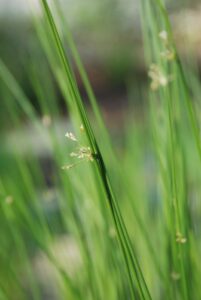
Juncus effusus (soft rush)
Herbaceous, perennial that often grows in tussocks or hummocks. Seed is a food source for waterfowl. Has a clumping habit.
- Wetland Indicator Status: OBL (Obligate Wetland)
- Height Range: 3 – 4 ft.
- Water Tolerance: MHW and above or irregular inundation
- Light: Full sun or partial sun/shade
- Rate of Spread: Slow
- Bloom color: Yellow/brown
- Drought tolerance: Low
- Bloom period: June through August
- Wildlife Value: Source of food for waterfowl
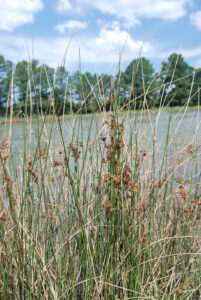
Juncus roemerianus (black needlerush)
Herbaceous, perennial that acts like a good marsh stabilizer. Flowers from spring to fall.
- Wetland Indicator Status: OBL (Obligate Wetland)
- Height Range: 1 – 4 ft.
- Water Tolerance: Near MHW
- Light: Full sun
- Rate of Spread: Medium
- Bloom color: Yellow/brown
- Drought tolerance: Low
- Bloom period: May through October
- Wildlife Value: Food and shelter
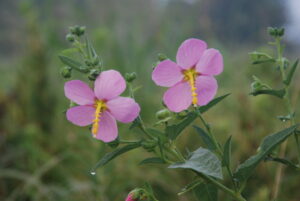
Kosteletzkya virginica (seashore mallow)
Herbaceous, perennial that has attractive pink flowers blooming in summer. Flowers attract hummingbirds.
- Wetland Indicator Status: NI (No Indicator)
- Height Range: 2 – 4 ft.
- Water Tolerance: Above MHW or irregular inundation
- Light: Full sun
- Rate of Spread: Slow
- Bloom color: Pink
- Drought tolerance: High
- Bloom period: July through September
- Wildlife Value: Attracts hummingbirds
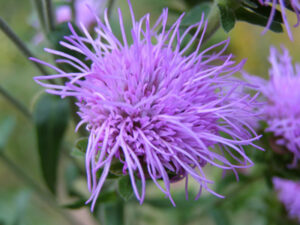
Liatris scariosa (savanna blazing star)
Reddish/purple thistle-like flowers August-October. Forms clumps; tolerates heat and some shade, requires good drainage. Attracts butterflies.
- Wetland Indicator Status: UPL (Upland)
- Height Range: 2 – 4 ft.
- Water Tolerance: Upland
- Light: Full sun to partial sun/shade
- Rate of Spread: Slow
- Bloom color: Reddish-Purple
- Drought tolerance: High
- Bloom period: August through October
- Wildlife Value: Attracts pollinators
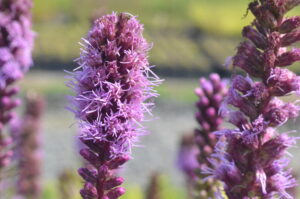
Liatris spicata (blazingstar)
Herbaceous, perennial that has bright purple spiked blooms during the late summer. Attracts a variety of pollinators and songbirds.
- Wetland Indicator Status: FAC (Facultative)
- Height Range: 1 – 6.5 ft.
- Water Tolerance: Seasonal inundation and upland
- Light: Full sun to partial sun/shade
- Rate of Spread: Slow
- Bloom color: Purple
- Drought tolerance: High
- Bloom period: July through August
- Wildlife Value: Attracts pollinators and songbirds
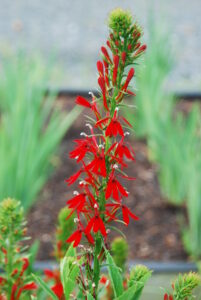
Lobelia cardinalis (cardinal flower)
Herbaceous, perennial with attractive scarlet flowers that grow in spikes. Blooms from summer through fall. Nectar supply for hummingbirds.
- Wetland Indicator Status: FACW (Facultative Wetland)
- Height Range: 1 – 5 ft.
- Water Tolerance: Near MHW and upland
- Light: Full sun to partial sun/shade
- Rate of Spread: Slow
- Bloom color: Red
- Drought tolerance: High
- Bloom period: July through October
- Wildlife Value: Attracts hummingbirds
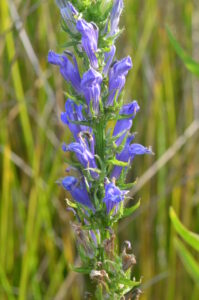
Lobelia siphilitica (great blue lobelia)
Herbaceous, perennial with attractive blue/purple flowers that grow in spikes. Blooms from late summer through fall. Attracts pollinators.
- Wetland Indicator Status: OBL (Obligate Wetland)
- Height Range: 1 – 3 ft.
- Water Tolerance: Irregular inundation
- Light: Partial sun/shade to full shade
- Rate of Spread: Slow
- Bloom color: Blue/purple
- Drought tolerance: High
- Bloom period: August through October
- Wildlife Value: Attracts pollinators
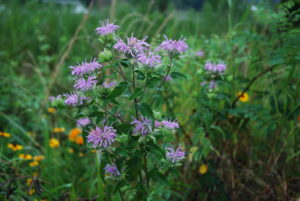
Monarda fistulosa (wild bergamot)
Herbaceous, perennial with fragrant pinkish-purple flowers blooming from June-September. Best in dry, well-drained soils. Attracts pollinators and hummingbirds.
- Wetland Indicator Status: FAC (Facultative)
- Height Range: 1.5 – 5 ft.
- Water Tolerance: Seasonal to regular inundation
- Light: Full sun to partial sun/shade
- Rate of Spread: Slow
- Bloom color: Pinkish-Purple
- Drought tolerance: Low
- Bloom period: June-September
- Wildlife Value: Attracts hummingbirds and pollinators
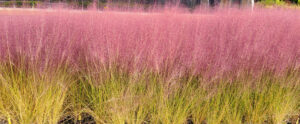
Muhlenbergia capillaris (pink muhly)
Dark green leaves; pink-purple flower spikes; heat, drought, poor soils tolerant, attracts beneficial insects.
- Wetland Indicator Status: FAC (Facultative)
- Height Range: 3 – 4 ft.
- Water Tolerance: Irregular inundation
- Light: Full sun to partial sun/shade
- Rate of Spread: Medium
- Bloom color: Pink
- Drought tolerance: Low
- Bloom period: Late summer to fall
- Wildlife Value: Attracts beneficial insects
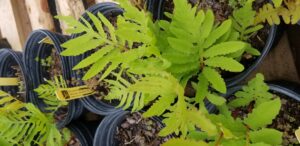
Onoclea sensibilis (sensitive fern)
Herbaceous, perennial fern that will grow well in average garden soil that does not dry out. Has a soil pH preference of 4.5 – 7.5.
- Wetland Indicator Status: FACW (Facultative Wetland)
- Height Range: 1 – 3 ft.
- Water Tolerance: Irregular to permanent inundation
- Light: Full sun to partial shade/sun to full shade
- Rate of Spread: Medium
- Bloom color: Non-flowering
- Drought tolerance: Low
- Bloom period: Non-flowering
- Wildlife Value: Habitat and/or shelter
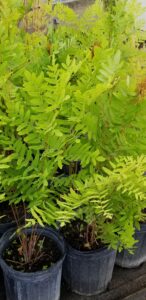
Osmunda regalis (royal fern)
Herbaceous, perennial fern. Provides food for many upland game birds and mammals. Prefers soils with a pH of 4.0 – 6.0.
- Wetland Indicator Status: OBL (Obligate Wetland)
- Height Range: 1 – 6 ft.
- Water Tolerance: Irregular to permanent inundation
- Light: Full sun to partial shade/sun to full shade
- Rate of Spread: Slow
- Bloom color: Non-flowering
- Drought tolerance: Low
- Bloom period: Non-flowering
- Wildlife Value: Provides food for birds and mammals
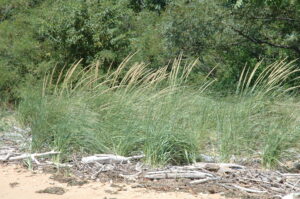
Panicum amarum (coastal panic grass)
Herbaceous, perennial deep-rooted bunch grass that grows best on coastal shores and dunes. Can tolerate drought. Provides food and cover for wildlife.
- Wetland Indicator Status: FAC (Facultative)
- Height Range: 1.5 – 6 ft.
- Water Tolerance: Irregular inundation and upland
- Light: Full sun
- Rate of Spread: Rapid
- Bloom color: Yellow/brown
- Drought tolerance: High
- Bloom period: August through October
- Wildlife Value: Provides food and cover for wildlife
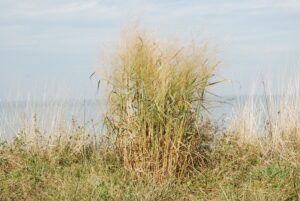
Panicum virgatum (switchgrass)
Herbaceous, perennial clumping grass with a delicate texture. Ornamental particularly in winter and flowers in the summer through late summer. Very high wildlife value.
- Wetland Indicator Status: FAC (Facultative)
- Height Range: 2 – 4 ft.
- Water Tolerance: MHW to upland
- Light: Full sun to partial sun/shade
- Rate of Spread: Slow
- Bloom color: Yellow/brown
- Drought tolerance: High
- Bloom period: July through September
- Wildlife Value: Provides food and cover for wildlife
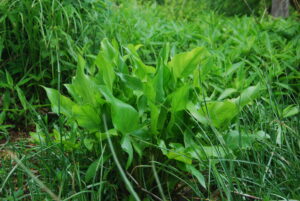
Peltandra virginica (arrow arum)
Herbaceous, perennial with inconspicuous green flowers in late spring. Attractive with a statuesque accent. Not subject to wildlife depredation. Seed preferred by wood duck.
- Wetland Indicator Status: OBL (Obligate Wetland)
- Height Range: 2 – 3 ft.
- Water Tolerance: Midtide – MHW or permanent inundation (0-18 in.)
- Light: Full sun or partial shade/sun
- Rate of Spread: Slow
- Bloom color: Green
- Drought tolerance: Low
- Bloom period: April through June
- Wildlife Value: Provides food for wood ducks
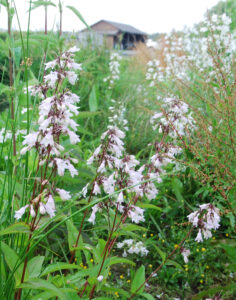
Penstemon digitalis (beardtongue)
Herbaceous, perennial with white flowers in the spring. Good ornamental value in meadows and landscapes.
- Wetland Indicator Status: FAC (Facultative)
- Height Range: 2 – 4 ft.
- Water Tolerance: Seasonal inundation to upland
- Light: Full sun or partial shade/sun
- Rate of Spread: Medium
- Bloom color: White
- Drought tolerance: High
- Bloom period: April through June
- Wildlife Value: Provides food and cover
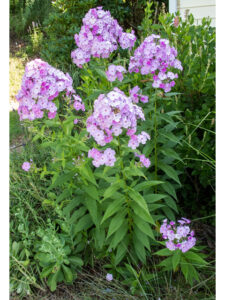
Phlox paniculata (fall phlox)
Herbaceous, perennial pink/lavendar flowers July-September; best in moist soils; not drought tolerant; attracts hummingbirds.
- Wetland Indicator Status: FACU (Facultative Upland)
- Height Range: 3 – 6′ ft.
- Water Tolerance: Upland
- Light: Partial shade/sun to full shade
- Rate of Spread: Slow
- Bloom color: Pink-lavender
- Drought tolerance: High
- Bloom period: July – September
- Wildlife Value: Attracts hummingbirds
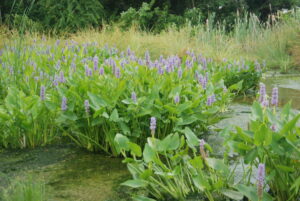
Pontederia cordata (pickerelweed)
Herbaceous, perennial with spikes of showy blue flowers blooming from summer to fall. Conspicuous heart-shaped leaves. Is of some interest to black and wood ducks.
- Wetland Indicator Status: OBL (Obligate Wetland)
- Height Range: 1 – 3.5 ft.
- Water Tolerance: Midtide – MHW or permanent inundation (0 – 12 in.)
- Light: Full sun to partial shade/sun
- Rate of Spread: Medium
- Bloom color: Blue
- Drought tolerance: Low
- Bloom period: June through November
- Wildlife Value: Food for waterfowl
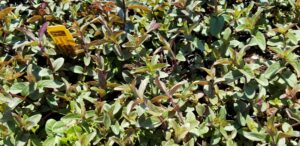
Pycnanthemum muticum (mountain mint)
Herbaceous, perennial with pink flowers blooming in mid to late summer. Long lasting silver-gray bracts – summer to fall. Mint scented foliage.
Wetland Indicator Status: FAC (Facultative)
- Height Range: 1 – 3 ft.
- Water Tolerance: Seasonal inundation to upland
- Light: Full sun to partial shade/sun
- Rate of Spread: Rapid
- Bloom color: Pink
- Drought tolerance: High
- Bloom period: July through September
- Wildlife Value: Provides food and shelter
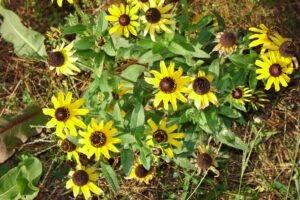
Rudbeckia fulgida (orange coneflower)
Herbaceous, perennial with yellow-orange blooms that have a dark brown center. Attracts songbirds and a variety of pollinators.
- Wetland Indicator Status: FAC (Facultative)
- Height Range: 1.5 – 3.5 ft.
- Water Tolerance: Irregular inundation and upland
- Light: Full sun to partial shade/sun
- Rate of Spread: Medium
- Bloom color: Yellow-orange
- Drought tolerance: High
- Bloom period: July through October
- Wildlife Value: Attracts pollinators and songbirds
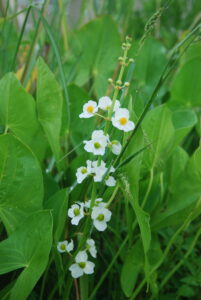
Sagittaria latifolia (duck potato)
Herbaceous, perennial with white flowers on a stalk that bloom from mid to late summer. Broad leaved plant. Underground tuber preferred by at least 15 species of duck.
- Wetland Indicator Status: OBL (Obligate Wetland)
- Height Range: 1 – 4 ft.
- Water Tolerance: Near Midtide or permanent inundation (0 – 18 in.)
- Light: Full sun to partial shade/sun
- Rate of Spread: Rapid
- Bloom color: White
- Drought tolerance: Low
- Bloom period: July through September
- Wildlife Value: Source of food for waterfowl
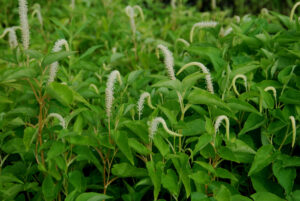
Saururus cernuus (lizard’s tail)
Herbaceous, perennial with attractive, nodding white flowers in spikes. Colonizes large areas. Favored by the wood duck. Drought resistant.
- Wetland Indicator Status: OBL (Obligate Wetland)
- Height Range: 1 – 4 ft.
- Water Tolerance: Near Midtide or permanent inundation (0 – 12 in.)
- Light: Full sun
- Rate of Spread: Rapid
- Bloom color: White
- Drought tolerance: High
- Bloom period: June through September
- Wildlife Value: Source of food for waterfowl
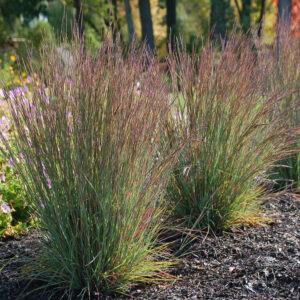
Schizachyrium scoparium (little bluestem)
Herbaceous, perennial clumping grass with delicate texture. Low maintenance and persistent.
- Wetland Indicator Status: FACU (Facultative Upland)
- Height Range: 2 – 3 ft.
- Water Tolerance: Irregular to upland
- Light: Full sun
- Rate of Spread: Slow
- Bloom color: Brown
- Drought tolerance: High
- Bloom period: August through February
- Wildlife Value: Source of cover
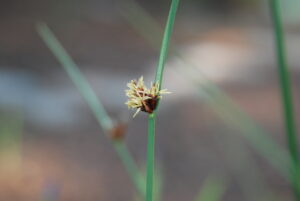
Scirpus pungens (three-square bulrush)
Herbaceous, perennial with erect triangular stems. Heavy predation by muskrat, nutria, geese, and birds. Flowers throughout the summer.
- Wetland Indicator Status: OBL (Obligate Wetland)
- Height Range: 1 – 4 ft.
- Water Tolerance: Midtide – MHW or permanent inundation (0 – 12 in.)
- Light: Full sun
- Rate of Spread: Rapid
- Bloom color: Brown
- Drought tolerance: Low
- Bloom period: June through September
- Wildlife Value: Source of food
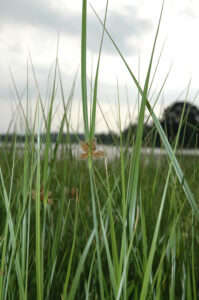
Scirpus robustus (sturdy or saltmarsh bulrush)
Herbaceous, perennial with triangular stems. Moderate wildlife value. Does well in fluctuating salinity. Flowers from summer through fall.
- Wetland Indicator Status: OBL (Obligate Wetland)
- Height Range: 1 – 4 ft.
- Water Tolerance: Near MHW
- Light: Full sun
- Rate of Spread: Rapid
- Bloom color: Brown
- Drought tolerance: Low
- Bloom period: July through October
- Wildlife Value: Source of food and cover
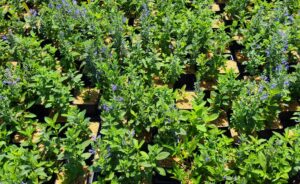
Scutellaria incana (hoary skullcap)
Blue-violet flower spikes June – September. Attracts hummingbirds and other pollinators. Deer and rabbit resistant. Drought tolerant, once established.
- Wetland Indicator Status: NL (not listed)
- Height Range: 1.5 – 3.5 ft.
- Water Tolerance: Upland
- Light: Full sun, partial sun/shad to full shade
- Rate of Spread: Medium
- Bloom color: Blue-violet
- Drought tolerance: Good, once established
- Bloom period: June – September
- Wildlife Value: Attracts hummingbirds and other pollinators
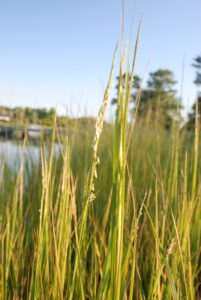
Spartina alterniflora/Sporobolus alterniflorus (smooth cordgrass)
Herbaceous, perennial shoreline grass. Birds eat seed and the rhizome is eaten by muskrat and geese. Shore erosion control
- Wetland Indicator Status: OBL (Obligate Wetland)
- Height Range: 4 – 7 ft.
- Water Tolerance: Midtide to MHW
- Light: Full sun
- Rate of Spread: Rapid
- Bloom color: Brown
- Drought tolerance: Low
- Bloom period: July-September
- Wildlife Value: Attracts wetland wildlife and birds
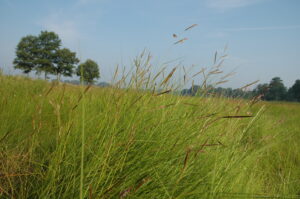
Spartina patens/Sporobolus pumilus (salt meadow hay)
Herbaceous, perennial shoreline grass. Tolerates drought once established. Good cover and nesting. Shore erosion control.
- Wetland Indicator Status: FACW (Facultative Wetland)
- Height Range: 1 – 3 ft.
- Water Tolerance: Above MHW
- Light: Full sun
- Rate of Spread: Medium
- Bloom color: Brown
- Drought tolerance: High
- Bloom period: April through May
- Wildlife Value: Provides cover and nesting
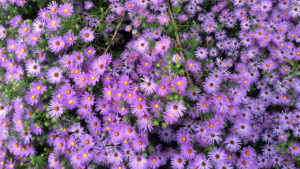
Symphyotrichum novae-angliae (New England aster)
Herbaceous, perennial with light pink-purple flowers. Blooms late in the season. Nectar source for butterflies and other pollinators.
- Wetland Indicator Status: FACW (Facultative Wetland)
- Height Range: 3 – 6 ft.
- Water Tolerance: Irregular inundation and upland
- Light: Full sun to partial sun/shade
- Rate of Spread: Slow
- Bloom color: Light pink/purple
- Drought tolerance: Low
- Bloom period: July through October
- Wildlife Value: Source of food for Monarchs and pollinators
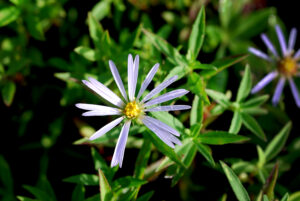
Symphyotrichum novi-belgii (New York aster)
Herbaceous, perennial with light blue-violet flowers. Blooms late in the season. Nectar source for butterflies and other pollinators.
- Wetland Indicator Status: OBL (Obligate Wetland)
- Height Range: 3 – 6 ft.
- Water Tolerance: Irregular inundation and upland
- Light: Full sun to partial sun/shade
- Rate of Spread: Slow
- Bloom color: Light blue/violet
- Drought tolerance: Low
- Bloom period: July through October
- Wildlife Value: Source of food for Monarchs and pollinators
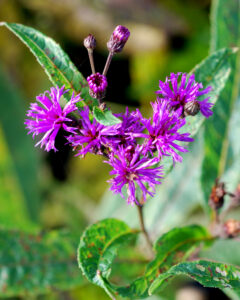
Vernonia noveboracensis (New York ironweed)
Herbaceous, perennial with vivid purple flowers in heads from late summer to early fall. Attracts butterflies.
- Wetland Indicator Status: FACW (Facultative Wetland)
- Height Range: 3 – 7 ft.
- Water Tolerance: Seasonal inundation
- Light: Full sun to partial sun/shade
- Rate of Spread: Slow
- Bloom color: Purple
- Drought tolerance: High
- Bloom period: August through September
- Wildlife Value: Attracts butterflies
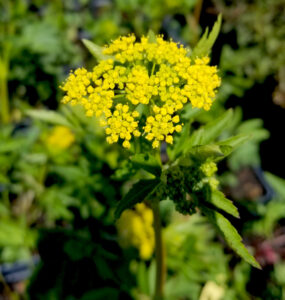
Zizia aptera (meadow zizia)
Herbaceous, perennial with yellow umbel flowers from spring to summer. Host plant for Black Swallowtail butterflies.
- Wetland Indicator Status: FACU (Facultative Upland)
- Height Range: 1 – 3 ft.
- Water Tolerance: Upland
- Light: Full sun to partial sun/shade
- Rate of Spread: Medium
- Bloom color: Yellow
- Drought tolerance: High
- Bloom period: May through June
- Wildlife Value: Host plant for Black Swallowtail butterflies
Plant Information-Shrubs & Trees (alphabetical)
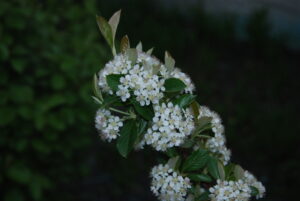
Aronia melanocarpa (black chokeberry)
Woody, perennial with white flowers in May and black fruit in September through November. Emergency winter food for many species. Grows in soils with a pH of 5.1 – 6.5.
- Wetland Indicator Status: FAC (Facultative)
- Height Range: 3 – 6 ft.
- Aerial Spread: 3 – 6 ft.
- Water Tolerance: Irregular to seasonal inundation
- Light: Full sun to partial sun/shade
- Bloom color: White
- Drought tolerance: High
- Bloom period: April through May
- Wildlife Value: Source of food
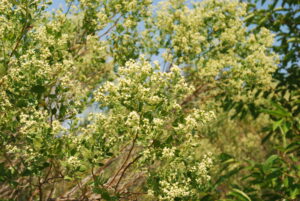
Baccharis halimifolia (groundsel tree)
Woody, perennial with white flowers in late summer. Poor soil stabilizer. Grows in soils with a pH of 7.0 – 8.5.
- Wetland Indicator Status: FAC (Facultative)
- Height Range: 6 – 12 ft.
- Aerial Spread: 6 – 12 ft.
- Water Tolerance: Above MHW or seasonal inundation
- Light: Full sun
- Bloom color: White
- Drought tolerance: High
- Bloom period: August through September
- Wildlife Value: Source of shade and cover
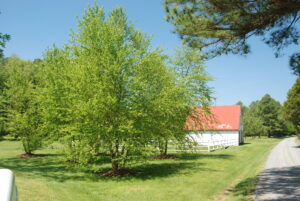
Betula nigra (river birch)
Woody, deciduous perennial with an attractive bark and yellow fall foliage. Used in forested riparian buffers and erosion control. Grows in soil with a pH of 4.0 – 6.5.
- Wetland Indicator Status: FACW (Facultative Wetland)
- Height Range: 50 – 75 ft.
- Aerial Spread: 35 – 50 ft.
- Water Tolerance: Seasonal inundation
- Light: Full sun
- Bloom color: Green/brown
- Drought tolerance: High
- Bloom period: April through May
- Wildlife Value: Source of shade and cover
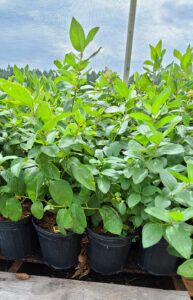
Ceanothus americanus (New Jersey tea)
Densely branched, fragrant white flowers May-September; gray-green leaves; nitrogen fixer. Requires good drainage; drought tolerant. Benefits pollinators
- Wetland Indicator Status: NL (not listed)
- Height Range: 3 ft.
- Aerial Spread: 3 – 5 ft.
- Water Tolerance: Upland
- Light: Full sun to partial sun/shade
- Bloom color: White flowers; gray-green leaves
- Drought tolerance: Good, requires good drainage
- Bloom period: May through September
- Wildlife Value: Benefits pollinators
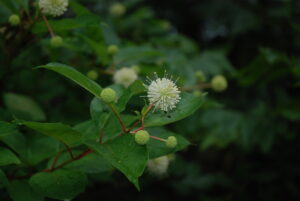
Cephalanthus occidentalis (buttonbush)
Woody, perennial with numerous tubular flowers in ball-shaped heads. Few flowers in full shade. Attracts butterflies and other beneficial insects. Will adapt to dry sites. Grows in soil with a pH of 6.1 – 8.5.
- Wetland Indicator Status: OBL (Obligate Wetland)
- Height Range: 6 – 12 ft.
- Aerial Spread: 12 – 15 ft.
- Water Tolerance: MHW and above or permanent inundation (0 – 12 in.)
- Light: Full sun to partial sun/shade to full shade
- Bloom color: White/green
- Drought tolerance: High
- Bloom period: May through August
- Wildlife Value: Attracts butterflies and other beneficial insects
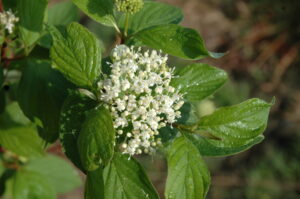
Cornus amomum (silky dogwood)
Woody, perennial with yellowish-white flowers in late spring/early summer and blue berries in the late summer. Very high food value to many songbirds and mammals.
- Wetland Indicator Status: FACW (Facultative Wetland)
- Height Range: 6 – 12 ft.
- Aerial Spread: 6 – 12 ft.
- Water Tolerance: Seasonal inundation
- Light: Full sun to partial shade/sun
- Bloom color: White
- Drought tolerance: High
- Bloom period: May through June
- Wildlife Value: Source of food for songbirds and mammals
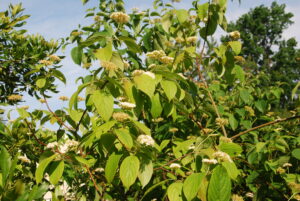
Cornus racemosa (gray twig dogwood)
Woody, perennial with white flowers in late spring/early summer and white berries in the late summer. Very high food value to waterfowl, songbirds, and mammals.
- Wetland Indicator Status: FAC (Facultative)
- Height Range: 6 – 12 ft.
- Aerial Spread: 6 – 12 ft.
- Water Tolerance: Seasonal inundation
- Light: Full sun to partial shade/sun to full shade
- Bloom color: White
- Drought tolerance: High
- Bloom period: May through June
- Wildlife Value: Source of food waterfowl, songbirds, and mammals
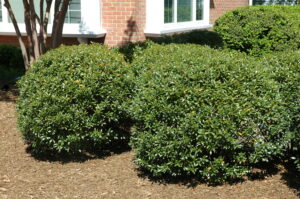
Ilex glabra (inkberry)
Woody, perennial with small, shiny evergreen leaves and black berries (on female plants). Provides emergency winter food and cover for birds and mammals. Fairly insensitive to disease and insect damage. Grows in soil with a pH of 4.5 – 6.0.
- Wetland Indicator Status: FACW (Facultative Wetland)
- Height Range: 6 – 12 ft.
- Aerial Spread: 6 – 12 ft.
- Water Tolerance: Seasonal inundation
- Light: Full sun to partial shade/sun to full shade
- Bloom color: Green/white
- Drought tolerance: High
- Bloom period: May through June
- Wildlife Value: Provides cover and food for birds and mammals
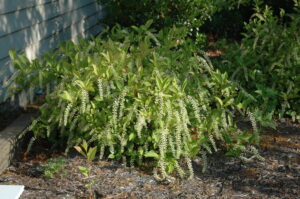
Itea virginica (Virginia sweetspire)
Woody, perennial with flowers in dense, upright, terminal, tassel-like, white spikes in the summer. Forms small, elongate capsules that persist until late March. Reliable red fall color. Prefers swamps and/or wet coastal areas with soils that have a pH of 5.0 – 7.0.
- Wetland Indicator Status: FACW (Facultative Wetland)
- Height Range: 6 – 12 ft.
- Aerial Spread: 6 – 12 ft.
- Water Tolerance: Regular or seasonal inundation
- Light: Full sun to partial shade/sun to full shade
- Bloom color: White
- Drought tolerance: High
- Bloom period: June through July
- Wildlife Value: Provides shelter
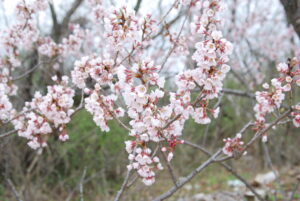
Prunus maritima (beach plum)
Woody, perennial with white flowers in spring and edible fruit in the late summer. Grows in soils with a pH of 5.8 – 7.7.
- Wetland Indicator Status: NI (No Indicator)
- Height Range: 1 – 8 ft.
- Aerial Spread: 3 – 6 ft.
- Water Tolerance: Upland
- Light: Full sun to partial shade/sun
- Bloom color: White
- Drought tolerance: High
- Bloom period: April through May
- Wildlife Value: Provides cover and shade
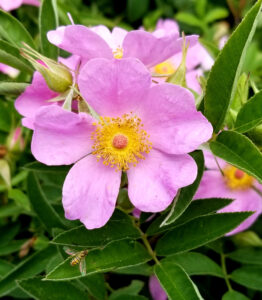
Rosa palustris (swamp rose)
Pink flowers bloom June-October; rose hips eaten by many species of birds; thorny, good nesting habitat.
- Wetland Indicator Status: Obligate
- Height Range: 2 – 7 ft.
- Aerial Spread: 4 – 6 ft.
- Water Tolerance: regular inundation 0-3″
- Light: Full sun to partial shade/sun
- Bloom color: Pink
- Drought tolerance: Low
- Bloom period: June through October
- Wildlife Value: Provides food source for many bird species
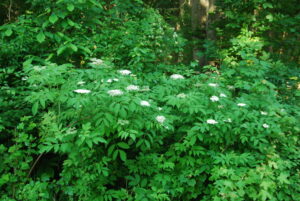
Sambucus canadensis (elderberry)
Woody, perennial with small white flowers in large flat-topped clusters in summer. Purple berries in late summer. Sends out suckers. Relished by birds. Hoofed browsers eat twigs
- Wetland Indicator Status: FACW (Facultative Wetland)
- Height Range: 6 – 12 ft.
- Aerial Spread: 6 – 12 ft.
- Water Tolerance: Seasonal inundation
- Light: Full sun to partial shade/sun to full shade
- Bloom color: White
- Drought tolerance: Low
- Bloom period: August through September
- Wildlife Value: Source of food for birds and hoofed browsers
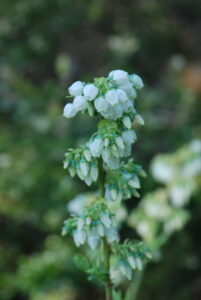
Vaccinium corymbosum (highbush blueberry)
Woody, perennial with white urn-shaped flowers in the spring and summer. Blue berries are a valuable food source for many species of wildlife. Only grows in soil with a pH of 3.5 – 6.0.
- Wetland Indicator Status: FACU (Facultative Upland)
- Height Range: 12 ft.
- Aerial Spread: 4 – 6 ft.
- Water Tolerance: Seasonal inundation
- Light: Full sun to partial shade/sun to full shade
- Bloom color: White
- Drought tolerance: High
- Bloom period: April through July
- Wildlife Value: Source of food for wildlife
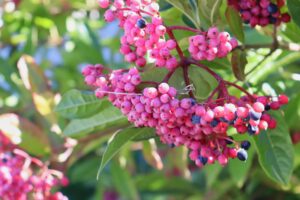
Viburnum nudum (possom-haw viburnum)
Small, broad, flat-topped clusters of white flowers in June-July; football shaped berries turn pink, then blue.
- Wetland Indicator Status: FACW (Facultative Wetland)
- Height Range: 6 – 20 ft.
- Water Tolerance: Seasonal or irregular inundation
- Light: Full sun to partial sun/shade to full shade
- Rate of Spread: Slow
- Bloom color: White
- Drought tolerance: Low
- Bloom period: June-July
- Wildlife Value: Food source for birds
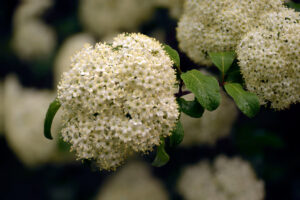
Viburnum prunifolium (black haw viburnum)
Small, broad, flat-topped clusters of white flowers in June-July; football shaped berries turn pink, then blue.
- Wetland Indicator Status: FACU (Facultative Upland)
- Height Range: 6 – 15 ft.
- Water Tolerance: Irregular inundation
- Light: Full sun to partial sun/shade to full shade
- Rate of Spread: Slow
- Bloom color: White
- Drought tolerance: Low
- Bloom period: Spring
- Wildlife Value: Food source for birds